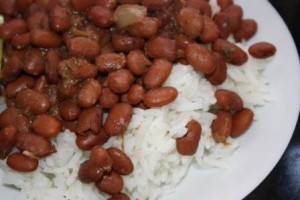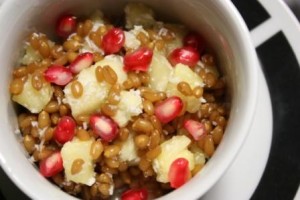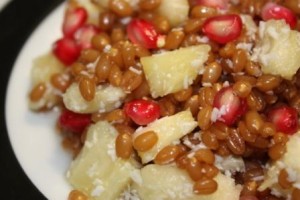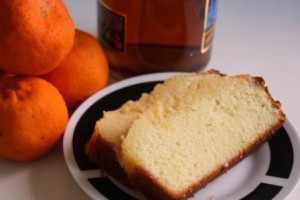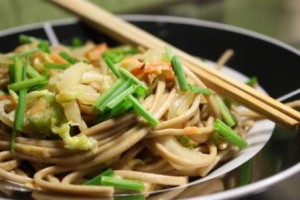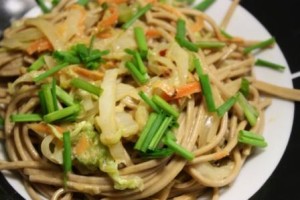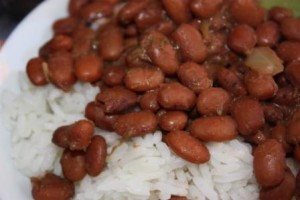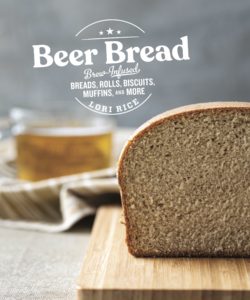Happy Monday!
I’m honored to have a guest post up at 5 Star Foodie today! Head on over to learn more about about Brazilian desserts and candy!
July 4th Links to a Healthy Weekend
July 4, 2009Well, I still didn’t get many posts up this week, but I couldn’t bear to leave you without any links for two weekends in a row. Although, I expect many of you are out enjoying summer fun on this 4th of July.

Here are a few great recipes, ideas and reads from the week.
Tropical Wheat Berry Salad
July 1, 2009I simply combined honey, lime and coconut for a dressing. Tossed some diced pineapple with cooked and cooled wheat berries. Pomegranate arils came about for color.
1 ¾ cup water
1/3 cup pineapple, finely chopped
2 tbsp honey
Juice of two limes
2 tbsp finely ground coconut
¼ cup pomegranate arils
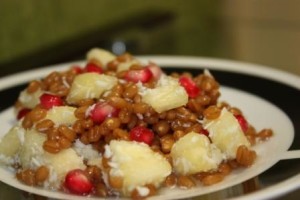
Tangerine Cake and Travel News!
June 29, 2009First things first, let’s talk dessert. A couple weekends ago I had a craving for a good pound cake, something with a bit of a citrus flavor. I had purchased a whole bag of tangerines at the farmer’s market planning to juice them. However, I haven’t been in the mood for cold juice.
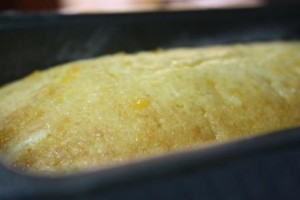
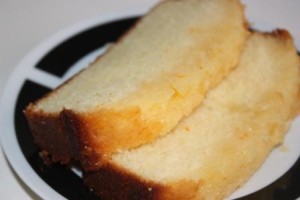
As many of you know, our two years (actually a little over that) in Brazil will soon be coming to an end in October. Since we made the decision to move here, we’ve had on our minds the idea of a long trip to close out the end of this adventure.
South America was the logical choice, but unfortunately the cost of traveling here is expensive. Not so much once you get to a place, but the act of getting there, as in the flight costs. We had big plans to see a lot of Brazil and South America while here.
Boy, were we wrong. Going to other countries from the small town we live in costs about the same as going there from the U.S. There are still a couple places we want to visit and we hope we stumble upon some fare sales, but as far as an around SA trip, well, it became much less appealing. Considering we want to see pretty much every country in this world, however, we were not left without options.
Europe came to mind because we still have so much to see there, but we have been there the past few years. I was actually planning to go back to Ireland with my husband while he worked this year and then both of us go on to Italy this year, but once again, plans changed.
Hmmm…so where else could we go? Maybe an area overflowing with foods made of coconut milk, curries, noodles and seafood where street food and food courts are the place to be. Places with lots of culture, beautiful beaches and some unbelievably inexpensive travel prices.
Yeah, that sounds good.
Ready? We’re going to Southeast Asia and I can hardly stand the excitement!
The month of October, before we settle back into the US and all the reverse culture shock that is sure to go with it, we will be traveling to – Hong Kong, Bangkok-Thailand, Chiang Mai-Thailand, Krabi-Thailand, Singapore, Kuala Lumpur-Malaysia and Bali-Indonesia.
Oh and don’t worry, you are going with me. The blog will, of course, turn into more of a food travel blog for that month, but I plan to share my food adventures with you as much as possible. In fact, I’ll be spending my 31st birthday at a Thai cooking class complete with a trip to the market!
To top off this already fantastic news our flight just happens to come back into San Francisco a few days before the big Foodbuzz event which I am anxiously awaiting details for. I’m planning to stay on a bit longer and attend. If you are going, let me know!
Have you been to the places we’re planning to go? I’ll gladly take any advice you want to share.
Cauliflower & Mandioquinha Soup
June 26, 2009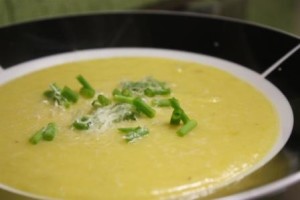 I’ve been trying to find a bit of balance lately. I’m talking about the fact that it is winter here. Well, more like a Kentucky October, but they call it winter. Despite the fact that temperatures aren’t plummeting into the 30s, I’m still having overwhelming cravings for cold weather foods. At the same time for many of you, it is summer and a darn hot one from all info I’m getting.
I’ve been trying to find a bit of balance lately. I’m talking about the fact that it is winter here. Well, more like a Kentucky October, but they call it winter. Despite the fact that temperatures aren’t plummeting into the 30s, I’m still having overwhelming cravings for cold weather foods. At the same time for many of you, it is summer and a darn hot one from all info I’m getting.
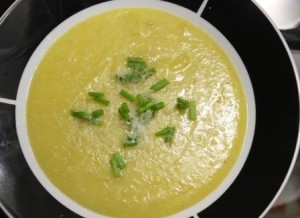
1 Tbsp olive oil
2 cloves garlic, minced
½ cup onion, diced
1/3 cup celery, diced
2 cups mandioquinha, chopped (or your root veggie substitute)
1 medium cauliflower with broken into small pieces
Salt and pepper to taste
3 cups chicken stock
½ to 1 cup milk
Chives and grated parmesan for garnish
Curious About Coconut Oil
June 24, 2009I’ve gladly embraced the coconut since I’ve been living in Brazil. As you can imagine it shows up in a lot of places around here. Those green coconuts with the tops chopped off and a straw inserted which most people seek out on their vacations, I now have access to everyday after my workouts at the park.
It’s a different world for me and while I was not a lover of coconut as a kid, it has grown on me quite rapidly in the past few years. Readily available as it may be, I will admit that it has been with reservation that I’ve generous added all forms of this food into my cooking.
Old habits die hard and when you are in a field where the dangers of saturated fats and all associated foods has been hammered into your head for years, it takes a while to adjust to new things. Then I started to read more and more about coconut oil. It’s nothing new, actually, been around forever, like most other natural, healthy foods, I might add.
I’ve been promising this post a while and I finally feel like I’ve done enough research to present what I’ve found and the views I’ve formed. It is really, really difficult to research topics like this in my opinion. I mean, 75% of the information out there that is understandable is from a company who sells coconut oil so you know they are going to present the positives. Yes, the info may be true, but one must read and believe with caution.
So here’s the breakdown.
Coconut oil has been used for a very long time in many of the cultures who have had easy access to it, India, Thailand, etc. Well, with our “eat low fat” mantra which eventually changed to a “eat healthy fat” mantra which is slowly becoming a “everything is okay except trans fat” mantra, coconut oil got a bit of a bad rap in the US.
Now this isn’t completely unwarranted. Much of what was being analyzed was refined and hydrogenated coconut oil, not good for you. However, the good stuff, the virgin coconut oil got thrown in with it making all coconut oil, no matter the source, bad for your heart, according to health professionals and some researchers.
Well, researchers (and lots of companies selling coconut oil) are now telling us that’s not true. I have to say, at this point, I agree.
Coconut oil has a high concentration of saturated fat, but this particular fat actually has two very positive qualities when it comes to health. One, it contains lauric acid. This gives coconut anti-bacterial, anti-microbial and anti-viral properties. You can find people all over the web swearing how good it works for the immune system and as a topical ointment.
Second, coconut oil is made up of medium chain fatty acids (MCFA) which are metabolized differently by the body than other fatty acids. They are absorbed more efficiently in our gastrointestinal tract and transported directly to the liver where they are utilized for energy. Long chain fatty acids, on the other hand, are converted into chylomicrons (substances that transport fats in the body) and go through the lymph system.
The big buzz around MCFA is that research studies have shown them to be associated with weight loss. Animal and human studies show an increase in energy expenditure after consumption leading researchers to believe they hold potential for promoting weight loss (1). In addition, another study concluded that intake of MCFA oils was more effective for weight loss than olive oil (2). In response to speculation that MCFA are associated with cardiovascular disease when used with weight loss programs, yet another study determined that there was no negative effect on metabolic risk factors (3). It was added in the conclusion that a distinction should be made on fatty acid chain length when discussing the effects of saturated fat on metabolic risk factors.
Okay, take a breather. Just a little more science stuff.
There has been some research linking coconut oil to improved cholesterol, but a lot of this has been in animal studies. Of course, that is where most nutritional research starts so it is worth mentioning. One study showed that the consumption of coconut oil by laboratory rats resulted in a decrease of total cholesterol, triglycerides and LDL (4). From what I have gathered even if some professionals believe coconut oil doesn’t necessarily improve cholesterol, they do recognize that it may not exactly hurt it either. That can be viewed as a positive when it comes to fats considering all the bad publicity they’ve had in the past.
Virgin coconut oil is where it’s at when it comes to health. This name means it has been extracted from young coconuts using little to no heat and is in its most natural from. Refined coconut oils sometimes labeled as RBD (refined, bleached, deodorized) can contain chemicals used in the processing and does not have the same nutrient profile as the virgin variety. Some people go for organic. I did read in my research that this wasn’t of utmost importance because coconuts don’t need a lot of pesticides to grow, but I can’t verify the accuracy of that information. I didn’t find anything else about that in my search.
Now for my minor rant.
I do believe that foods have medicinal, healing and even miracle properties and coconut oil just might be one. However, I dislike it when foods are advertised like this. Why? Well, because that is what we do in the U.S. with fads and most fads are dishonest. The miracle cure, the potential weight loss, etc. may be true, but turning things into fads and quick fixes is where we get ourselves into trouble. I feel by doing this we are buying into the fact that health is about quick fixes and not lifestyle.
I feel that foods should be about nourishment and enjoyment and the miracles a bonus for being healthy.
So you won’t find me taking coconut oil medicinally by the teaspoonful like I have read about. Mostly because, well, that is what we do with medicine. Food can act as medicine, but I prefer to enjoy it as food. I do believe that coconut oil has health benefits and I plan to start incorporating it into my diet more when possible. Although probably not a lot considering the price, but I’m certainly not going to be avoiding it like I used to.
So far I’ve only enjoyed it as a spread on bread and I hope to eventually start cooking and baking with it more. It is only sold in small jars here and while I haven’t searched too hard I haven’t seen it in bulk.
My next step is to determine if coconut milk and grated, unsweetened coconut contain the same benefits as the oil. I’m thinking probably not since they may be processed, but if you have info on that, send it my way. I use these much more in my cooking. So far all I’ve found on it is from the About.com guide for Alternative Medicine. She states that 3 ½ tablespoons of coconut oil is equal to about 10 ounces of coconut milk when it comes to lauric acid and the milk is processed differently so the nutrient and chemical makeup is likely different as well.
Do you use coconut oil?
References
1. Papamandjaris AA, MacDougall DE and Jones PJ. Medium chain fatty acid metabolism and energy expenditure: obesity treatment implications. Life Sci 1998;62(14):1203-15
2. St – Onge MP and Bosarge A. Weight-loss diet that includes consumption of medium-chain triacylglycerol oil leads to a greater rate of weight and fat mass loss than does olive oil. Am J Clin Nutr 2008 Mar;87(3):621-6
3. St – Onge MP et al. Medium chain triglyceride oil consumption as part of a weight loss diet does not lead to an adverse metabolic profile when compared to olive oil. J Am Coll Nutr. 2008 Oct;27(5):547-52
4. The Weston A. Price Foundation: The Latest Studies on Coconut Oil by Mary G. Enig, Ph.D.
Resources
A New Look at Coconut Oil
Coconut Research Center
Health Benefits of Coconut Oil
Blog Posts
Food Renegade
Nourishing Gourmet
This post has been submitted as part of Food Renegade’s Fight Back Fridays!
Soba with Spicy Peanut Sauce
June 23, 20092 cloves garlic, minced
¼ of a large onion, thinly sliced
½ cup carrot, shredded
1 cup zucchini, shredded
1 cup Napa cabbage, shredded or thinly sliced
Salt and pepper to taste
250 g soba noodles, cooked
2 Tbsp chives or scallions, sliced
2 Tbsp (generous) creamy peanut butter
1 Tbsp soy sauce
1 tsp sesame oil
1/8 cup water
1 clove garlic, minced
½ tsp ground ginger
½ tsp crushed red pepper (less or more depending on taste)
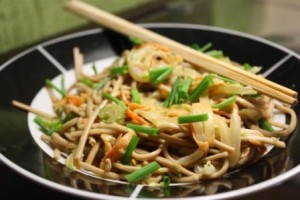
Hope I didn’t miss anyone. I owe you all a cafezinho!
Links to a Healthy Weekend
June 20, 2009Taco Calzones with Avocado Cream was shared by food for living. I was so happy to find the Homemade Taco Seasoning Blend at the end of the post. I want to get away from using the packets, but I’m never quite sure what to put together to add the right flavor. Now I’ve got it.
Make your life more like travel by Gadling was an inspiring post I think most of us can relate to. It definitely gives you something to think about regarding enjoying where you are, positive attitude and everyday life.
Coconut and Lime Wheat Scones
June 18, 2009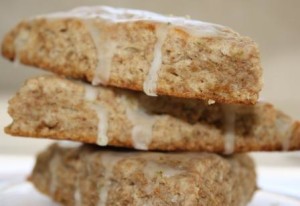 I think my love of scones has been pretty well established. I just can’t get enough of them. A donut? Eh, maybe. A bagel? Well, okay. Scones? Yes! Bring them on over. It is with these treats that I love to do my breakfast splurging.
I think my love of scones has been pretty well established. I just can’t get enough of them. A donut? Eh, maybe. A bagel? Well, okay. Scones? Yes! Bring them on over. It is with these treats that I love to do my breakfast splurging.
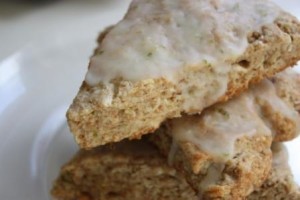 1 ¾ cup whole wheat flour
1 ¾ cup whole wheat flour2 ¼ tsp baking powder
2 tbsp mascavo sugar (unrefined cane sugar)
½ tsp salt
1 tbsp lime zest (about half from one lime)
¼ cup finely ground unsweetened coconut
¼ cup unsalted butter, cold
1/3 cup coconut milk
¼ to ½ cup milk or heavy cream
Juice of one lime
1 Tbsp lime zest
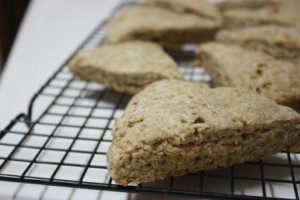
Add ½ cup powdered sugar to a small bowl. Add the juice of one lime and whisk until smooth. Whisk in the lime zest and enough of the remaining powdered sugar to reach desired consistency. It should be slightly thick, but still thin enough to drizzle and glaze.
Pour glaze over each scone and allow it to harden. Enjoy!

Rice and Beans: A Not-Quite-Brazilian Version
June 16, 2009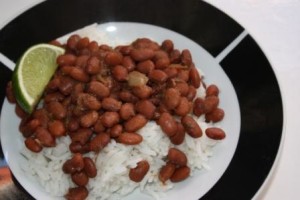 4 cups red/white beans, soaked overnight in 8 cups water
4 cups red/white beans, soaked overnight in 8 cups water
8 cups water
1 ½ cups chicken stock
1 Tbsp olive oil
1/2 large onion, chopped
1 small green pepper, chopped
4 cloves garlic minced
1 tsp cumin
¼ tsp crushed red pepper
½ tsp hot paprika
½ tsp salt
¼ tsp black pepper
Juice of one lime
1 Tbsp olive oil
1 cup long grain rice
2 cups water
